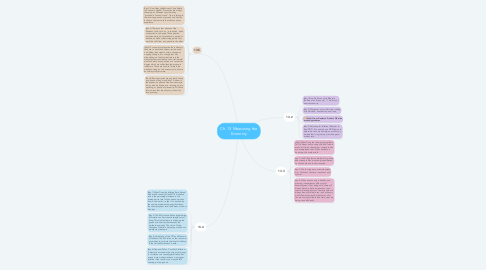Ch. 13 Measuring the Economy
by ABIGAIL GONZALES

1. 13.4
1.1. (Key.1) What Does the Inflation Rate Reveal About an Economy’s Health? The inflation rate is the percentage increase in the average price level of goods and services from one month or a year. It's tracked by the same government agency that tracks the unemployment rate, the Bureau of Labor Statistics. -
1.2. (Key.2) The BLS tracks inflation by gathering information on Americans'average cost of living. This studies the cost of buying the goods and services that households purchase every day. The cost of living changes all the time because prices do not always stay the same.
1.3. (Key.3) Limitations of the CPI as a Measure of Inflation: The BLS relies on the consumer price index to estimate the level of inflation in the United States each month.
1.4. (Key.4) Demand-Pull vs. Cost-Push Inflation: . A dramatic increase in the amount of money in circulation can cause hyperinflation. But even a more modest increase may trigger inflation if the result is too many dollars chasing too few goods.
2. 13.5
2.1. (Key.1) How Does the Business Cycle Relate to Economic Health? Economies are always changing. as Wheelan says that they “proceed in fits and starts.” He is referring to the recurring periods of growth and decline in the economic activity that all economies experience.
2.2. (Key.2) There are four phases of the Business Cycle such as ... expansion, peak, contraction, and trough. These phases include a period of growth and a period of decline, as well as the turning points that mark the shift from one period to the other.
2.3. (Key.3) Economists categorize the indicators they use to track the business cycle based on whether they signal a future change, an ongoing change, or a change that has already begun. Leading indicators is the measures that consistently rise or fall several months before an expansion or a contraction begins which are called leading economic indicators. These are used to forecast the peak and trough of a business cycle, but are not always fully accurate.
2.4. (Key.4) Business cycles are popularly known as periods of boom and bust. A boom is the expansion phase of the business cycle. It may also be known as a recovery, upturn, upswing, or period of prosperity. All these terms mean that the economy is healthy and growing.
3. 13.2
3.1. (Key.1)How Do Economists Measure the Size of an Economy? - The focus of macroeconomics.
3.2. (Key.2) Macroeconomics: Decision making of individuals, households, and firms.
3.3. (Key.3) Gross Domestic Product: What an economy produces.
3.4. (Key.4) Adjusting for Inflation (Nominal vs. Real GDP) : Economists use GDP figures to determine not only how big an economy is, but whether it is growing or shrinking and at what rate.
4. 13.3
4.1. (Key.1) What Does the Unemployment Rate Tell Us About an Economy’s Health? In hard economic times, the number of people who are unemployed rises. When business is booming, the number falls.
4.2. Key.2- the BLS gathers detailed information about people who are unemployed. Based on those data and further research,
4.3. Key.3- The four types on unemployment are: Frictional, structural, seasonal, and cyclical.
4.4. Key.4- When an economy is healthy and growing, it experiences little cyclical unemployment. That being said, there will always be some frictional, seasonal, and structural unemployment. Some people will always be out of work, even in an economy with full employment. At that point, all of the economy's available labor resources are being used efficiently.


